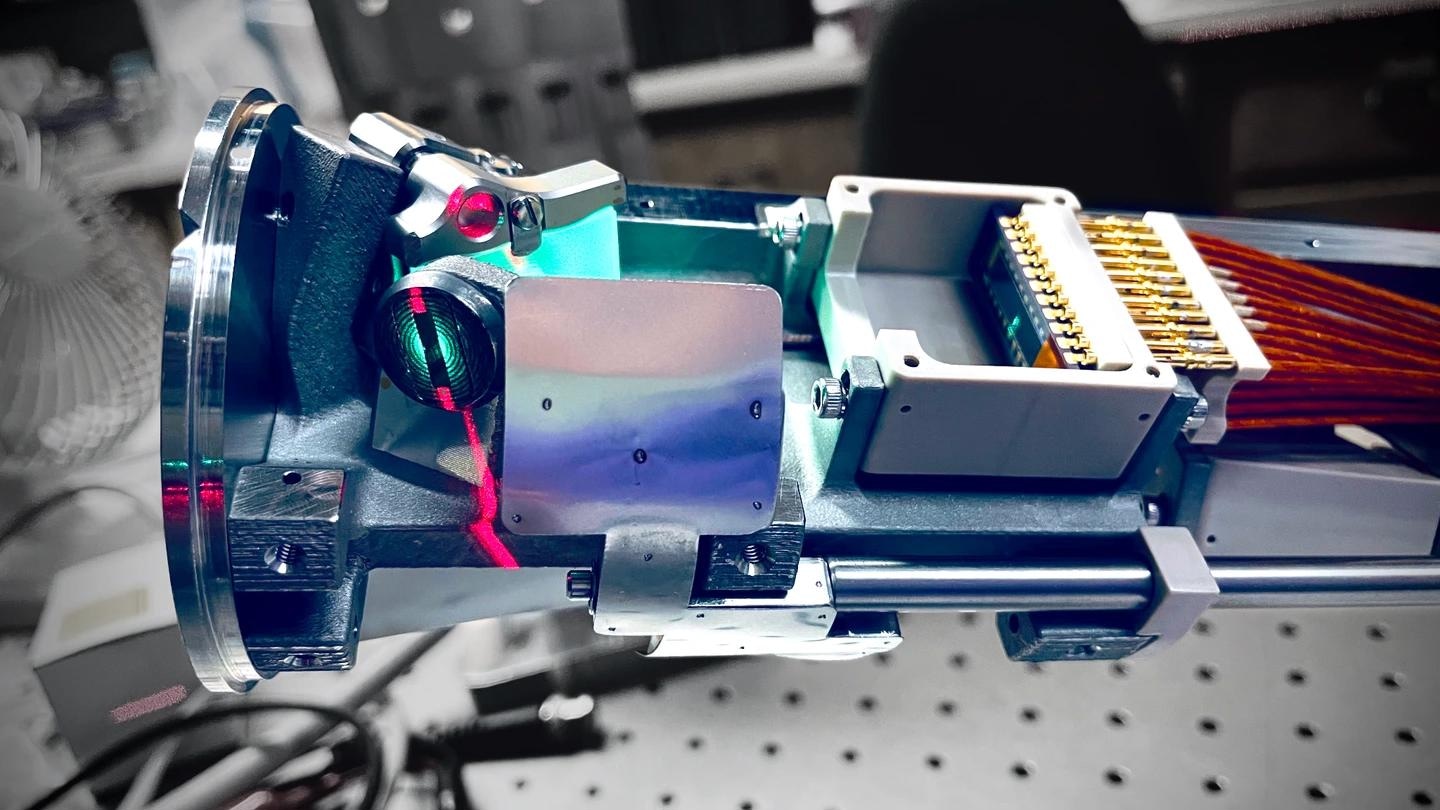Reviewed by Lexie CornerMay 2 2024
The Princeton Plasma Physics Laboratory (PPPL) of the US Department of Energy (DOE) has built a new instrument called ALPACA to study the density of neutral atoms surrounding hot plasma in a fusion reactor. The study was published in the journal Nuclear Fusion.
 The ALPACA measurement device being aligned using red and green lasers. Image Credit: Laszlo Horvath / PPPL
The ALPACA measurement device being aligned using red and green lasers. Image Credit: Laszlo Horvath / PPPL
It takes skill to control the properties of plasma (the electrically charged fourth state of matter that makes up 99 % of the visible universe) to produce heat from fusion reactions.
ALPACA measures light from a halo of neutral atoms encircling the plasma inside DIII-D, a doughnut-shaped device called a tokamak run by General Atomics in San Diego on behalf of the DOE. By analyzing this light, researchers can learn details about the density of the neutral atoms, which may aid in maintaining the plasma's temperature and boosting the power produced by fusion reactions.
Scientists worldwide are working to harness the fusion reactions that power stars to produce electricity on Earth without releasing long-lived radioactive waste or greenhouse gases.
ALPACA facilitates research on the fueling process. Clouds of neutral atoms with different densities surrounding the plasma disintegrate during this process, releasing electrons and ions that enter the plasma.
We’re interested in fueling because neutral atom density can increase plasma particle density, and plasma density affects the number of fusion reactions. If we can increase the plasma’s density, then we can have more fusion reactions, which generate more fusion power. That’s exactly what we want to have in future fusion power plants.
Laszlo Horvath, Physicist, Princeton Plasma Physics Laboratory
Horvath helped coordinate ALPACA’s assembly and installation.
Three sources provide the hydrogen atoms used in this kind of fueling. First, there are the original hydrogen gas puffs that scientists used to start the plasma. In the chamber's colder areas, electrons and nuclei combine to form entire atoms, which is the second process. The third is the escape of hydrogen atoms from the substance constituting the inner chamber surfaces, where they can become trapped occasionally while tokamak operations are underway.
The nearly 2-foot-long ALPACA, which functions similarly to a pinhole camera, gathers plasma light with a particular characteristic called the Lyman-alpha wavelength. By measuring the brightness of the light, scientists can determine the density of neutral atoms. In the past, scientists have deduced the density from measurements made with different equipment, but the information has proven challenging to understand.
ALPACA's data is much clearer because it is one of the first diagnostics specifically made to collect plasma light at the Lyman-alpha frequency.
To control fueling, scientists are trying to learn more about it. Scientists could boost the efficiency of the fusion reactions in tokamaks and increase the amount of heat they produce by having control over fueling. The increased heat is significant because a tokamak-based power plant’s ability to produce more electricity increases with plasma temperature. This project exemplifies PPPL's exceptional proficiency in engineering and plasma diagnostics.
One of the two diagnostics is ALPACA. “LLAMA,” which stands for “Lyman-alpha measurement apparatus,” is the name of its twin. The two diagnostics are complementary to one another because ALPACA observes the inner and outer regions of the tokamak, whereas LLAMA observes the lower part's inner and outer regions.
We need both devices because, although we know that neutral atoms surround the plasma, the number of neutral atoms varies from place to place, so we don’t know exactly where they accumulate. Because of that, and because we can’t extrapolate from single measurements, we have to measure in multiple locations.
Alessandro Bortolon, Principal Research Physicist, Princeton Plasma Physics Laboratory
Bortolon also heads PPPL collaboration with the DIII-D National Fusion Facility.
Like all diagnostics, ALPACA serves a crucial purpose. Horvath said, “When we are running experiments on machines like DIII-D, we need to understand what is going on inside the device, especially if we want to boost its performance. But because the plasma is at 100 million degrees Celsius, we can’t just use an oven thermometer or anything conventional. They would just melt. Diagnostics give us knowledge about what would otherwise be a black box.”
ALPACA’s design incorporated 3D printing, a technique that allowed the integration of a hollow chamber inside the main structural backbone for cooling conduits.
There would be no way to machine this part in any other way. This is the first big project for which I’ve handled the majority of the mechanical engineering. There were challenges—figuring out the positioning of the optical components, for instance—but the process was fun.
David Mauzey, Senior and Technical Associate, Princeton Plasma Physics Laboratory, San Diego State University
Mauzey also led the mechanical engineering aspects of the ALPACA project.
Although PPPL alone designed and constructed ALPACA, the Massachusetts Institute of Technology and PPPL will work together to operate the entire system, which consists of ALPACA and LLAMA. Alexander Nagy, the deputy head of PPPL’s DIII-D off-site research, and Florian Laggner, an assistant professor of nuclear engineering at North Carolina State University, both made significant contributions.
ALPACA is being tested right now. When DIII-D returns online in April following a maintenance window, ALPACA will begin collecting real measurements.
The Office of Science of the DOE provided funding for this work.
Journal Reference:
Bortolon, A., et al. (2024) DIII-D research advancing the physics basis for optimizing the tokamak approach to fusion energy. Nuclear Fusion. doi.org/10.1088/1741-4326/ac2ff2